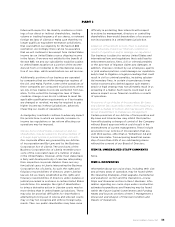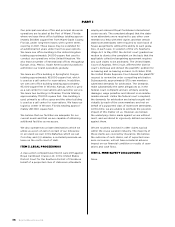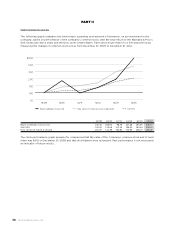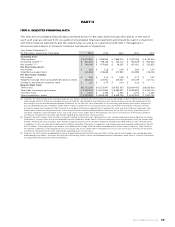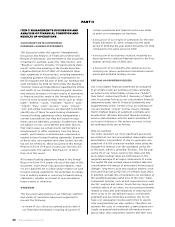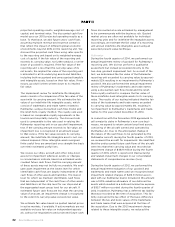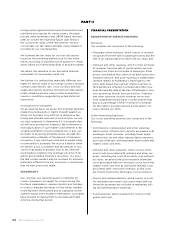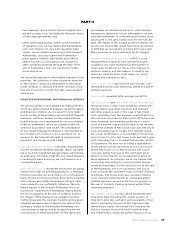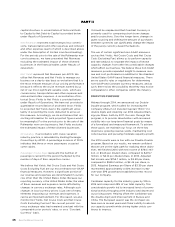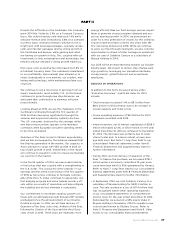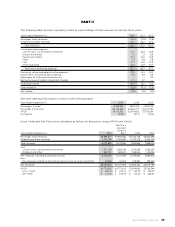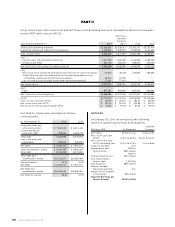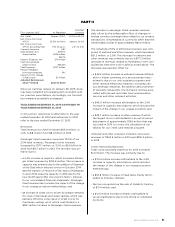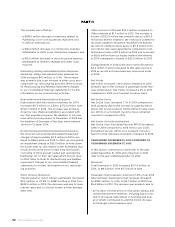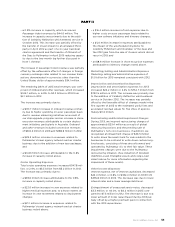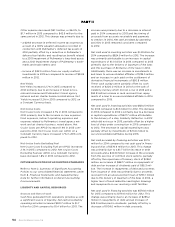Royal Caribbean Cruise Lines 2014 Annual Report Download - page 45
Download and view the complete annual report
Please find page 45 of the 2014 Royal Caribbean Cruise Lines annual report below. You can navigate through the pages in the report by either clicking on the pages listed below, or by using the keyword search tool below to find specific information within the annual report.
44 Royal Caribbean Cruises Ltd.
PART II
pricing inputs against actual market transactions and
published price quotes for similar assets. We apply
present value techniques and LIBOR-based discount
rates to convert the expected future cash flows to
the current fair value of the instruments. We also
corroborate our fair value estimates using valuations
provided by our counterparties.
We estimate the fair value for our fuel call options
based on the prevailing market price for the instru-
ments consisting of published price quotes for similar
assets based on recent transactions in an active market.
We adjust the valuation of our derivative financial
instruments to incorporate credit risk.
We believe it is unlikely that materially different esti-
mates for the fair value of our foreign currency forward
contracts and interest rate, cross-currency and fuel
swaps and options would be derived from other appro-
priate valuation models using similar assumptions,
inputs or conditions suggested by actual historical
experience.
Contingencies—Litigation
On an ongoing basis, we assess the potential liabilities
related to any lawsuits or claims brought against us.
While it is typically very difficult to determine the
timing and ultimate outcome of such actions, we use
our best judgment to determine if it is probable that
we will incur an expense related to the settlement or
final adjudication of such matters and whether a rea-
sonable estimation of such probable loss, if any, can
be made. In assessing probable losses, we take into
consideration estimates of the amount of insurance
recoveries, if any, which are recorded as assets when
recoverability is probable. We accrue a liability when
we believe a loss is probable and the amount of loss
can be reasonably estimated. Due to the inherent
uncertainties related to the eventual outcome of liti-
gation and potential insurance recoveries, it is possi-
ble that certain matters may be resolved for amounts
materially different from any provisions or disclosures
that we have previously made.
SEASONALITY
Our revenues are seasonal based on demand for
cruises. Demand is strongest for cruises during the
Northern Hemisphere’s summer months and holidays.
In order to mitigate the impact of the winter weather
in the Northern Hemisphere and to capitalize on the
summer season in the Southern Hemisphere, our brands
have focused on deployment to Australia and Latin
America during that period.
FINANCIAL PRESENTATION
DESCRIPTION OF CERTAIN LINE ITEMS
Revenues
Our revenues are comprised of the following:
• Passenger ticket revenues, which consist of revenue
recognized from the sale of passenger tickets and the
sale of air transportation to and from our ships; and
• Onboard and other revenues, which consist primarily
of revenues from the sale of goods and/or services
onboard our ships not included in passenger ticket
prices, cancellation fees, sales of vacation protection
insurance and pre- and post-cruise tours. Additionally,
revenue related to Pullmantur’s travel agency net-
work, land-based tours and air charter business to
third parties are included in onboard and other reve-
nues through the date of the sale of Pullmantur’s non-
core businesses further discussed below. Onboard
and other revenues include revenues we receive
from independent third-party concessionaires that
pay us a percentage of their revenues in exchange
for the right to provide selected goods and/or ser-
vices onboard our ships.
Cruise Operating Expenses
Our cruise operating expenses are comprised of the
following:
• Commissions, transportation and other expenses,
which consist of those costs directly associated with
passenger ticket revenues, including travel agent
commissions, air and other transportation expenses,
port costs that vary with passenger head counts and
related credit card fees;
• Onboard and other expenses, which consist of the
direct costs associated with onboard and other rev-
enues, including the costs of products sold onboard
our ships, vacation protection insurance premiums,
costs associated with pre- and post-cruise tours and
related credit card fees as well as the minimal costs
associated with concession revenues, as the costs
are mostly incurred by third-party concessionaires;
• Payroll and related expenses, which consist of costs
for shipboard personnel (costs associated with our
shoreside personnel are included in marketing, sell-
ing and administrative expenses);
• Food expenses, which include food costs for both
guests and crew;



